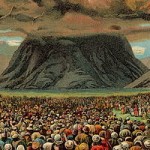The delayed honeymoon
 It is strange to find Simchat Torah at the end of the holyday period.
It is strange to find Simchat Torah at the end of the holyday period.
After all, Shavu’ot, months earlier, is Z’man Mattan Toratenu – “the time of the giving of our Torah”.
Why, then, were Simchat Torah and Shavu’ot not joined together and made into one impressive day of celebration?
The question was raised between two famous rabbinical figures of the 18th century, the Vilna Gaon and the Dubner Maggid.
The Gaon asked the Maggid, “Since Shavu’ot was the day of the union between the Jewish people and the Torah, why did the bride and groom wait for four months before celebrating their simchah?”
As was his custom, the Maggid answered with a parable.
Once, he told the Gaon, there was a king who was happily married to his queen, but they had no children. None of the doctors could help, but the king heard that there was a wise sage in a little village who was so pious that his prayers were always answered.
The rabbi assured the king that he would duly pray for the queen to bear a child, but on condition that when the child, a daughter, was born, she should never look upon the face of a man until her wedding day.
The king and queen had no choice but to agree, and arrangements were made for the queen and a staff of women to go to an uninhabited island and for the child to be born and brought up there.
Teachers were sent to the island in due course to instruct the princess in music, languages, and everything else she needed to know, and she grew into a beautiful and accomplished young woman.
When she was 20, the king, who had never seen his daughter, decided she should be married.
He interviewed princes from many countries who all sought her hand in marriage, but when told that they would not be able to see the princess until the wedding day most departed in a hurry, certain that there was something wrong with her.
Only one prince was prepared to accept the condition, and the wedding was arranged. When he saw her for the first time he was amazed at her beauty; when they got to know each other he found she was highly intelligent and had a kindly nature. After four months of marriage he knew how fortunate he was, and he decided to hold a great banquet in her honour and to celebrate her virtues.
Thus, said the Maggid, God invited all the ancient peoples to accept His Torah, but they all insisted on scrutinising it first. None would accept the Almighty’s promise that the Torah was beautiful and a blessing.
Only one people, Israel, was prepared to take the risk and to say na’aseh v’nishma – “We will observe it, we will obey it”.
Nonetheless, when Israel and the Torah joined each other at Mount Sinai neither was well acquainted with the other, and it took time to learn each other’s virtues.
After four months, they knew they were right for one another, and they then said so by means of a day of celebration which they called Simchat Torah.



